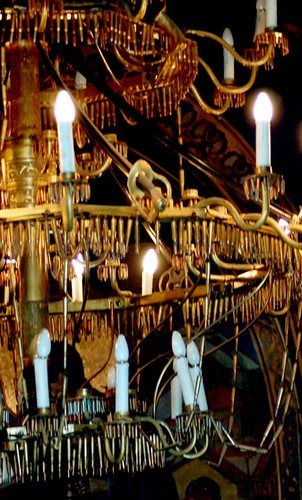Here is an article from: http://curiousexpeditions.org/?p=70 that I have just stumbled across and thought that readers may be interested in.
The Lethal Chandeliers of Ružica Church
August 16th, 2007
 A gasp jumps from the lips of a surprised onlooker as their eyes fall on something that seems entirely out of place in this holy environment. One looks closer to examine it to make sure they are not mistaken. They are not. Lighting the frescoed walls of Ružica Church, a small chapel built into the side of Kalemegdan fortress, are two chandeliers made entirely of spent bullet casing, swords, and cannon parts. It is a more fitting decoration than one might realize.
A gasp jumps from the lips of a surprised onlooker as their eyes fall on something that seems entirely out of place in this holy environment. One looks closer to examine it to make sure they are not mistaken. They are not. Lighting the frescoed walls of Ružica Church, a small chapel built into the side of Kalemegdan fortress, are two chandeliers made entirely of spent bullet casing, swords, and cannon parts. It is a more fitting decoration than one might realize.
A recent Curious Expeditions trip brought M and I to the Kalemegdan Fortress in Belgrade, Serbia. TheKalemegdan Fortress is as old as Beograd itself. Controlled at various times by the Serbs, Turks, Hungarians, and Austrians, the small dark church tucked in the Fortress’http://curiousexpeditions.org.nyud.net/; side has seen a lot of action. The space the church now occupies was used by the Turks as gunpowder storage for over 100 years and it had to be largely rebuilt in 1920 after WWI. Though damaged by bombings there was an upshot to the terrible carnage of The Great War. While fighting alongside England and the US, Serbian soldiers on the Thessaloniki front took the time to put together these two amazing chandeliers.
WWI produced many artistic wonders. Wrought from brass artillery casing, and other detritus of war, these beautiful creations have come to be known as trench art. Artillery shells become candle holders, bullets are turned into lighters, shrapnel becomes a tiny plane. All crafted by dirty mud spattered soldiers, with their hands and the tools they had around them, all with death only a mortar shell away.
 As long as there has been large scale war there has been trench art of one form or another. In the Napoleonic wars, the soldiers carved animal bones into complex ships. In the American Civil wars snuff boxes and game pieces were made from bone and bullets. Trench art would “http://curiousexpeditions.org.nyud.net/;explode”http://curiousexpeditions.org.nyud.net/;, as it were, with WWI and the heavy use of machine guns and artillery. With all that used metal lying around the soldiers had plenty of material to work with. As written in a British soldier’http://curiousexpeditions.org.nyud.net/;s letter,
As long as there has been large scale war there has been trench art of one form or another. In the Napoleonic wars, the soldiers carved animal bones into complex ships. In the American Civil wars snuff boxes and game pieces were made from bone and bullets. Trench art would “http://curiousexpeditions.org.nyud.net/;explode”http://curiousexpeditions.org.nyud.net/;, as it were, with WWI and the heavy use of machine guns and artillery. With all that used metal lying around the soldiers had plenty of material to work with. As written in a British soldier’http://curiousexpeditions.org.nyud.net/;s letter,
“http://curiousexpeditions.org.nyud.net/;The lads in the trenches while away the flat time by fashioning rings, crosses, and pendants out of bullets and the softer parts of shells.”http://curiousexpeditions.org.nyud.net/;
More complex items were made farther from the front lines, with simple blacksmithing techniques.
 “http://curiousexpeditions.org.nyud.net/;The shell case would then be filled either with a wooden block, molten lead or heated sand. This ensured that, when punching onto the side of the shell, a small indentation is made rather than a wider dent. Eventually the whole design would be hammered out through this simple process.”http://curiousexpeditions.org.nyud.net/;
“http://curiousexpeditions.org.nyud.net/;The shell case would then be filled either with a wooden block, molten lead or heated sand. This ensured that, when punching onto the side of the shell, a small indentation is made rather than a wider dent. Eventually the whole design would be hammered out through this simple process.”http://curiousexpeditions.org.nyud.net/;
The fundamental creative urge shines through tremendously in these items. What could be more a better way to spend one’http://curiousexpeditions.org.nyud.net/;s time in war than transforming the implements of death around you into objects that celebrate human ingenuity and artistry. The chandeliers that hang in Ružica Church, with cannon wheels as top level, sabers as supports, artillery cases as center columns and an uncountable number of bullet casings adorning them, may be one of the greatest example of Trench Art ever made.
Some excellent examples of Trench Art after the leap…http://curiousexpeditions.org.nyud.net/;







The The Lethal Chandeliers of Ružica Church by Curious Expeditions, unless otherwise expressly stated, is licensed under a Creative Commons Attribution-Share Alike 3.0 United States License.
No comments:
Post a Comment